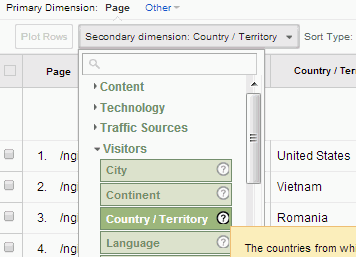Secondary Dimension in Google Analytics: Unlocking Advanced Metrics
Enhance Your Data Analysis Using Secondary Dimension in Google Analytics
Checking out the capabilities of second measurements in Google Analytics opens up a realm of opportunities for refining information analysis. By layering extra dimensions onto primary data sets, an even more complex story arises, shedding light on customer communications and performance indicators.
Recognizing Second Measurements
Additional dimensions in Google Analytics refer to added parameters that can be added to the primary dimension, enabling for a much more thorough analysis of data (Secondary Dimension in Google Analytics). By integrating second measurements, analysts can segment and filter data to uncover patterns, patterns, and relationships that could not be obvious when looking at the information as a whole.

Benefits of Using Additional Dimensions
When examining data in Google Analytics, the use of secondary dimensions uses vital understandings into user behavior and efficiency metrics. By adding an additional dimension to your key information, you can delve much deeper right into the features of your site site visitors and their interactions. Among the crucial benefits of making use of secondary measurements is the capacity to section and contrast data extra successfully. This division permits you to comprehend just how different variables, such as demographics or website traffic sources, effect user habits and conversions (Secondary Dimension in Google Analytics).
Moreover, additional dimensions aid in determining patterns and correlations that might not be quickly evident when looking at the data alone. This much deeper degree of analysis can uncover important details that can direct marketing approaches, website optimization, and overall business decisions. Additionally, secondary dimensions enhance the context of your primary data, offering a more extensive sight of user interaction and performance metrics. Generally, making use of second measurements in Google Analytics can dramatically enhance the deepness and top quality of your information analysis, causing more informed decision-making and improved end results.
Exactly How to Include Second Measurements
By incorporating additional dimensions in Google Analytics, users can gain much deeper understandings into their information analysis procedure, permitting more detailed assessment of individual habits and efficiency metrics. Adding second measurements is an uncomplicated procedure that can significantly boost the depth of evaluation. To add a second dimension in Google Analytics, beginning by navigating to the report you intend to assess. Once in the record, locate the "Additional dimension" tab above the information table. Click on it to expose a dropdown menu with different options such as Actions, Innovation, and Customized Capacities. Select the dimension you wish to add, such as 'Source/Medium' or 'Tool Category'. This second dimension will certainly then be why not try this out put on your existing information, supplying additional context and enabling a much more in-depth evaluation of individual communications. By using second dimensions efficiently, users can uncover beneficial understandings that might have otherwise been forgotten, bring about informed decision-making and enhanced efficiency techniques.
Studying Information With Secondary Dimensions
Utilizing additional measurements in information analysis provides a more comprehensive understanding of user actions and efficiency metrics. By adding an additional measurement to your primary data embeded in Google Analytics, you can dig much deeper right into the qualities of your web site visitors and their interactions. Integrating the primary measurement of 'source/medium' with the second dimension of 'landing web page' can expose which particular pages are attracting website traffic from various sources, assisting you enhance these pages for far better interaction.

Essentially, examining data with secondary dimensions equips you to acquire beneficial insights into customer actions, determine fads, and make notified decisions to boost the performance of your digital properties.
Finest Practices for Additional Dimensions
In information analysis, integrating secondary measurements successfully can considerably enhance the depth of insights originated from metrics and individual habits you could try this out patterns. When utilizing additional dimensions in Google Analytics or any type of various other logical device, it is crucial to abide by ideal methods to make sure the accuracy and significance of the information analysis.
One key best practice is to meticulously choose secondary dimensions that enhance the primary measurement being examined. Picking additional measurements that offer added context or additional segmentation can offer a more extensive understanding of the data. It is additionally necessary to stay clear of overcomplicating the analysis by consisting of as well several additional measurements, which might bring about confusion or dilution of insights.
Moreover, it is a good idea to experiment with various combinations of main and second dimensions to reveal new connections and fads. Routinely evaluating and refining the choice of second measurements based on the specific goals of the analysis can lead to more actionable understandings. By following these finest practices, data analysts can take advantage of additional measurements properly to boost the overall data analysis procedure and decision-making abilities.

Verdict
To conclude, incorporating secondary measurements in Google Analytics is essential for a thorough information analysis technique. By leveraging second measurements together with main ones, experts and marketing experts can discover important insights and correlations that can inform decision-making and enhance electronic advertising strategies. Understanding just how to successfully use second measurements and complying with best techniques will certainly permit specialists to draw out meaningful information and improve their general efficiency metrics.
Secondary measurements in Google Analytics refer to additional specifications that can be added to the key measurement, important link enabling for a more thorough evaluation of information. By integrating additional dimensions, analysts can section and filter data to reveal patterns, patterns, and connections that may not be evident when looking at the information as a whole. Combining the key dimension of 'source/medium' with the additional dimension of 'landing page' can disclose which particular pages are drawing in traffic from different resources, assisting you maximize these pages for much better interaction.
One key ideal method is to thoroughly pick secondary dimensions that enhance the key dimension being examined. By complying with these finest practices, data analysts can utilize additional dimensions efficiently to improve the overall data evaluation procedure and decision-making abilities.